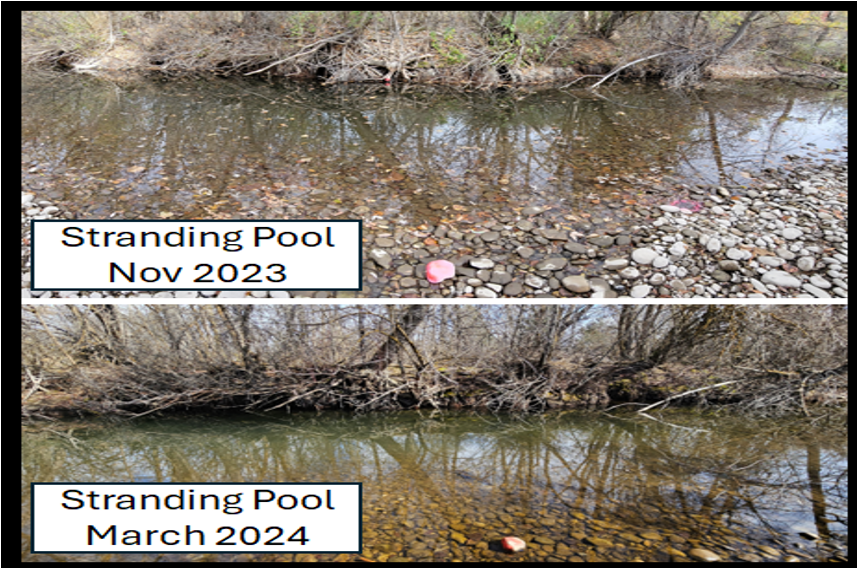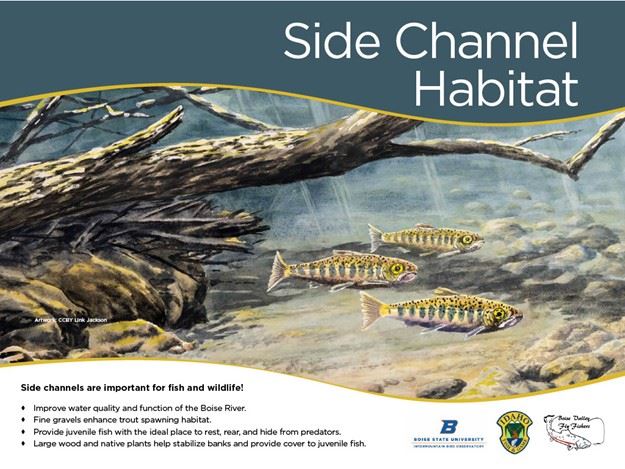Restoring Winter Flows to the Les Bois Side Channels
By Troy Pearse, Conservation Committee Chairperson
Conservation@BVFF.com
In 2017, after extended high water flows from Snowmageddon runoff, BVFF anglers recognized that 2 side channels behind the old Les Bois racetrack at Expo Idaho no longer flowed during the winter. This was very concerning because the 2 side channels represented a mile of premium trout spawning and rearing habitat. In 2019, BVFF started talking with Idaho Fish and Game, and although they shared our concern, they said they needed concrete evidence that the side channels used to flow during the winter. In 2021 we found dated aerial photography that clearly shows both side channels used to flow during the winter, as shown in the figure below, which gave IDF&G the evidence they needed.

In Spring of 2022, IDF&G put together a project team with key people from city, county and regulatory agencies and visited the site to discuss options for restoring winter flows. All parties were supportive of the project and suggestions from that meeting included monitoring the side channels during rewatering to observe how they flow and doing a test-dig at the head of the side channels to make sure the soils were solid enough to excavate without risking the river overtaking a side channel.
Last Spring, BVFF monitored the side channels as river levels came up and documented that the upper side channel flows through with very little inflows, but the lower side channel has more high-spots that kept water from flowing until the main Boise River was higher. Given this information, the project team recommended focusing on restoring flows to the upper side channel first and then applying lessons learned to the lower side channel.
One thing Zach Kirk, County Engineer from Ada County Development Services, noticed while we were documenting the side channel rewatering last year is there were some juvenile fish in the deeper pools that had survived the winter. We wanted to know more about the fish stranding in this disconnected side channel so last Fall, after flows dropped for the winter, IDF&G electro-fished the side channels and rescued trout that were stranded in the disconnected pools. Over the following winter, BVFF monitored two of these stranding pools and found that the water levels were relatively stable, and that dace and shiners (minnows) were able to survive the winter. This means the pools were connected to groundwater which was able to keep adequate oxygen levels for fish to survive, which is an important learning that stranding does not necessarily mean mortality if the pools are connected to groundwater. It also helps if the pools have some depth and enough woody-cover for the fish to avoid predation from birds like mergansers and herons. The location of the stranding pool study is shown on the aerial photo above and the photos below show the stranding pool levels last November and this March.

Getting permits to work in the river is expensive and takes time. This Fall the Flood District obtained the permits needed to dig the side channel entry test-pits and we were able to get good data on substrate and depth-to-groundwater that will help with modeling and plans for excavating the side channels. Here is the new Flood District Manager, Mark Zirschky, monitoring the test-dig at the top of the upper Les Bois side channel. The flood district is interested in helping this project both because they are great partners who want to help improve trout habitat and because they recognize that when side channels like this lose their carrying capacity the overall flood risk on the river increases.
monitoring the test-dig at the top of the upper Les Bois side channel. The flood district is interested in helping this project both because they are great partners who want to help improve trout habitat and because they recognize that when side channels like this lose their carrying capacity the overall flood risk on the river increases.
This year, BVFF volunteers again monitored the side channels as flows on the Boise River increased and rewatered the side channels. We gathered cross-sectional depths and flows to document where water will go once the side channel entry is excavated, which will help guide the river restoration work and possible trout habitat improvements such as adding spawning gravel or woody cover. We also documented where the river crossed the first high-spot in the lower side channel, to help guide the excavation at that location. Here is the BVFF crew (Klaus Kissman, Jeff Jones, Tim Opp and Mike Stahl) taking measurements at the entry to the upper Les Bois side channel. Meanwhile George Butts was in the lower side channel photo-documenting the water as it crossed the first high spot.

Side channels are important for trout spawning and rearing. They tend to have more spawning size gravels available as well as better woody-cover which improves fry survival. IDF&G does a yearly fry survey on the Lower Boise River and they find 7 – 10 times the fry density in side channels as they do in the main river, which reinforces how important side channels are to the trout population. Restoring side channels is one of the best ways to improve the trout population, but it is a difficult undertaking, and it couldn’t happen without cooperation and leadership from multiple agencies. BVFF is very excited to be a part of this project team and would like to thank Idaho Fish and Game for their leadership; Flood District 10 for their efforts to lead the excavation work; and the City of Boise for helping fund the river modeling necessary to do this complicated project. If all goes well, we could see the upper side channel excavation this upcoming winter!


